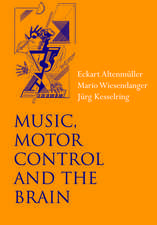Metabolic Compartmentation and Neurotransmission: Relation to Brain Structure and Function: NATO Science Series A:, cartea 6
Editat de Soll Berlen Limba Engleză Paperback – 26 noi 2012
Din seria NATO Science Series A:
- 15%
 Preț: 656.58 lei
Preț: 656.58 lei - 15%
 Preț: 655.13 lei
Preț: 655.13 lei - 15%
 Preț: 678.35 lei
Preț: 678.35 lei -
 Preț: 397.38 lei
Preț: 397.38 lei - 5%
 Preț: 377.87 lei
Preț: 377.87 lei -
 Preț: 397.76 lei
Preț: 397.76 lei - 18%
 Preț: 1232.41 lei
Preț: 1232.41 lei - 5%
 Preț: 731.64 lei
Preț: 731.64 lei -
 Preț: 413.15 lei
Preț: 413.15 lei - 15%
 Preț: 649.22 lei
Preț: 649.22 lei - 5%
 Preț: 369.45 lei
Preț: 369.45 lei -
 Preț: 407.56 lei
Preț: 407.56 lei - 5%
 Preț: 2162.19 lei
Preț: 2162.19 lei -
 Preț: 407.39 lei
Preț: 407.39 lei -
 Preț: 396.40 lei
Preț: 396.40 lei - 15%
 Preț: 663.93 lei
Preț: 663.93 lei -
 Preț: 387.38 lei
Preț: 387.38 lei -
 Preț: 393.13 lei
Preț: 393.13 lei -
 Preț: 398.35 lei
Preț: 398.35 lei -
 Preț: 401.24 lei
Preț: 401.24 lei - 15%
 Preț: 678.81 lei
Preț: 678.81 lei -
 Preț: 395.09 lei
Preț: 395.09 lei - 18%
 Preț: 952.40 lei
Preț: 952.40 lei - 15%
 Preț: 654.43 lei
Preț: 654.43 lei -
 Preț: 402.00 lei
Preț: 402.00 lei -
 Preț: 401.24 lei
Preț: 401.24 lei - 15%
 Preț: 655.27 lei
Preț: 655.27 lei -
 Preț: 394.71 lei
Preț: 394.71 lei -
 Preț: 384.48 lei
Preț: 384.48 lei - 5%
 Preț: 395.61 lei
Preț: 395.61 lei - 5%
 Preț: 1421.57 lei
Preț: 1421.57 lei - 15%
 Preț: 651.34 lei
Preț: 651.34 lei -
 Preț: 400.10 lei
Preț: 400.10 lei -
 Preț: 386.99 lei
Preț: 386.99 lei - 5%
 Preț: 386.11 lei
Preț: 386.11 lei -
 Preț: 403.91 lei
Preț: 403.91 lei - 15%
 Preț: 651.51 lei
Preț: 651.51 lei -
 Preț: 393.90 lei
Preț: 393.90 lei - 5%
 Preț: 376.43 lei
Preț: 376.43 lei -
 Preț: 400.26 lei
Preț: 400.26 lei - 5%
 Preț: 388.84 lei
Preț: 388.84 lei -
 Preț: 400.65 lei
Preț: 400.65 lei - 5%
 Preț: 740.58 lei
Preț: 740.58 lei - 18%
 Preț: 1225.16 lei
Preț: 1225.16 lei - 5%
 Preț: 386.46 lei
Preț: 386.46 lei -
 Preț: 421.82 lei
Preț: 421.82 lei
Preț: 420.08 lei
Nou
Puncte Express: 630
Preț estimativ în valută:
80.40€ • 82.86$ • 67.88£
80.40€ • 82.86$ • 67.88£
Carte tipărită la comandă
Livrare economică 03-17 martie
Preluare comenzi: 021 569.72.76
Specificații
ISBN-13: 9781461343219
ISBN-10: 1461343216
Pagini: 748
Ilustrații: XXIII, 721 p.
Greutate: 1.17 kg
Ediția:1975
Editura: Springer Us
Colecția Springer
Seria NATO Science Series A:
Locul publicării:New York, NY, United States
ISBN-10: 1461343216
Pagini: 748
Ilustrații: XXIII, 721 p.
Greutate: 1.17 kg
Ediția:1975
Editura: Springer Us
Colecția Springer
Seria NATO Science Series A:
Locul publicării:New York, NY, United States
Public țintă
ResearchCuprins
1 Glutamic Acid, a Putative Neurotransmitter of Cerebellar Granule Cells: Evidence from the Virally Induced Granuloprival Cerebellum.- 2 Gamma-Aminobutyric and Glutamic Acids as Mammalian Central Transmitters.- 3 Neurochemical Evidence for Glycine as a Transmitter and a Model for Its Intrasynaptosomal Compartmentation.- 4 Uptake and Localization of Transmitter Amino Acids in the Nervous System.- 5 Glial Transport of Amino Acid Neurotransmitter Candidates.- 6 The Localization of Glutamate Decarboxylase, Choline Acetyltransferase, and Aromatic Amino Acid Decarboxylase in Mammalian and Invertebrate Nervous Tissue.- 7 Uptake of Transmitter Candidates as an Approach to Their Localization.- 8 The Olfactory Pathway as a Model Cerebral System.- 9 Techniques for Separation of Neurons and Glia and Their Application to Metabolic Studies.- 10 Compartmentation of Striatal Dopamine: Problems in Assessing the Dynamics of Functional and Storage Pools of Transmitters.- 11 Regulation of Synthesis and Release Processes in Central Catecholaminergic Neurons.- 12 Cyclic AMP and Protein Phosphorylation in the Central Nervous System in Relation to Synaptic Function.- 13 Ortho- and Retrograde Trophic Effects on Adrenergic Neurons: Regulation of Enzyme Synthesis by the Activity of Preganglionic Fibers and Retrograde Axonal Transport of Nerve Growth Factor.- 14 Contractile Proteins in Relation to Transmitter Release.- 15 Physiology of CNS Tissues in Culture.- 16 The Culture of Established Clones for Neurobiology Investigation.- 17 Introduction to Simulation Techniques in Neurochemistry.- 18 Metabolic Compartmentation in the Brain and Effects of Metabolic Inhibitors.- 19 Factors Affecting the Development of Metabolic Compartmentation in the Brain.- 20 Effect of 1-Hydroxy-3-Aminopyrrolidone-2 and other CNS Depressants on Metabolic Compartmentation in the Brain.- 21 (i) Biochemical Dissection of the Cerebellum—Introduction.- 21 (ii) Biochemical Dissection of the Cerebellum—Subcellular Fractionation of Rat Cerebellum. Electron Microscopy: A Guide and Safeguard.- 21 (iii) Biochemical Dissection of the Cerebellum—Enzyme Composition of Subcellular Fractions, Including Complex Structures Derived from the Cerebellar Glomeruli.- 21 (iv) Biochemical Dissection of the Cerebellum—Functional Properties of the “Glomerulus Particles”.- 21 (v) Biochemical Dissection of the Cerebellum—Isolation of Perikarya from the Cerebellum with Weil-Preserved Ultrastructure.- 22 Ethanol and Its Relation to Amino Acid Metabolism in Brain.- 23 An Experimental Model of CNS Changes Associated with Chronic liver Disease: Portocaval Anastomosis in the Rat.- 24 Further Support for the Subdivision of the Small Metabolic Compartment: Effect of Halothane.- 25 Compartmentation of Citric Acic Cycle and Related Enzymes in Distinct Populations of Rat Brain Mitochondria.- 26 Relationship between Amino Acid and Catecholamine Metabolism in Brain.- 27 A Model of Glutamate Metabolism in Brain: A Biochemical Analysis of a Heterogeneous Structure.- 28 Glucose and Ketone-Body Utilization in Young Rat Brain: A Compartmental Analysis of Isotopic Data.- 29 Transmethylation and Transsulfuration Enzymes in Rat Brain: Their Subcellular Distribution.- 30 Some Processes Involved in Regulating the Function of Brain 5-Hydroxytryptamine.- 31 The Kinetics of 5-Hydroxyindoleacetic Acid Excretion from Rat Brain and CSF: Preliminary Studies and Multicompartment Analysis.- 32 Synthesis and Storage of Acetylcholine in Cholinergic Nerve Terminals.- 33 The Origin and Some Possible Mechanisms of the Release ofAcetylcholine at Synapses.- 34 Dynamics of Acetylcholine Compartments at Rest and During Nerve Activity.- 35 Preferential Release of Newly Synthesized Acetylcholine by Cortex Slices from Rat Brain.- 36 Maturation and Aging of Vertebrate Neurons.

















